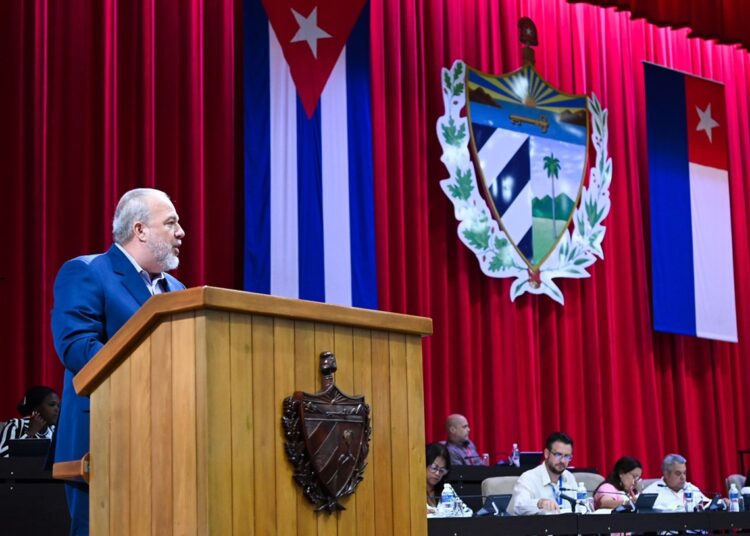A year after launching a promising macroeconomic stabilization program before parliament to be implemented during 2024, the government recognized that it had not “made the necessary progress” and that it only had “discreet results.”
Before the plenary session of the National Assembly of People’s Power, Prime Minister Manuel Marrero stated that the government feels “dissatisfaction” with the limited progress of the stabilization program, which includes reducing and eliminating subsidies and large cuts in public spending.
The official indicated that the dissatisfaction is concentrated in national agricultural production, which, being so depressed, leads the government to make up the basic food basket with imports, which supposes a drain on extremely reduced coffers.
According to his analysis, among the causes that would be behind the meager results, material problems, old-fashioned inertia and misrepresentations of resolutions and orientations stand out.
However, he balanced, many distortions have been identified, for which reason the impact of their damages was reduced, and several of the actions will have positive results gradually, indicated a report from the Cubadebate website.
For Marrero, the anti-crisis package supervised by the high hierarchy of the Communist Party is “a non-magical way” to promote what he described as a “real option for success” for economic growth.
Just a year ago, and from within Parliament, Marrero announced the plan “with the aim of restoring the macroeconomic requirements that will guarantee a favorable environment for economic growth, development and the process of socialist construction,” which has failed as the Gross Domestic Product has not grown this year either.
Among the objectives of this strategic initiative was also the recovery of the tourism industry to restore its role as the driving force of the economy, which also failed to happen as it fell well below 3.2 million foreign visitors and only attracted around 2.2 million.
Natural events
The chief of staff said that the blow of two hurricanes and two large-magnitude earthquakes has depleted public finances in 2024 and limited the State’s ability to maneuver amid a “war economy.”
Despite the results, he said that the “path of eliminating subsidies has no turning back,” which is one of the government’s tools to reduce the still large fiscal deficit.
The prime minister anticipated that Cuba expects a deficit for 2025 of 88.5 billion Cuban pesos (3.687,5 billion dollars, at the official exchange rate for legal entities), a figure similar to that of this year and the two previous years.
Last week, during the ninth Plenary Session of the Central Committee of the Communist Party, Marrero had anticipated that the deficit for this year would finally be around 90 billion pesos, 57 billion less than initially forecast in the public accounts.
However, independent economists such as Pedro Monreal and Pavel Vidal point out that this volume of deficit would be around 10% of the Gross Domestic Product (GDP), which is one of the highest rates in the world, only surpassed by Ukraine, a country amid a war with Russia.
“The main structural distortion of the Cuban budget is not so much that there was a deficit in its current account, but the existence of the enormous gap that represents the total budget deficit, which, in the case of Cuba, is covered mainly by the issuance of liquidity in conditions of supply restrictions, generating strong inflationary pressure,” Monreal observed.
Fines for the private sector
On the other hand, Marrero stated that Cuba has collected around 40.8 million dollars in fines from private enterprises that did not respect the price cap on products such as sausages, milk and chicken.
He also charged against private enterprises that, in his opinion, have sold products at a high price by using the exchange rate for the dollar on the informal market as a reference, reported the Spanish news agency EFE.
He also criticized the high circulation of cash in the economy, despite the intense campaign initiated since 2023 by the government to digitize transactions through a bancarization process enthroned at a forced pace in the face of the paper money crisis.
According to preliminary data shared by Marrero, there was a 26% year-on-year increase in the number of circulating bills, a factor, he said, that “impacts inflation rates.” According to Minister of Economy and Planning Joaquín Alonso Vázquez, it will fluctuate between 25% and 30% in 2025.
The state enterprise law: not yet
Marrero reported that it was decided again to postpone, now until December of next year, the discussion and preparation of the Law on the Socialist State Enterprise, since the current conditions of the country, he argued, in the midst of a “war economy,” do not advise approving the regulation, given that it could not be fully implemented.
A year ago, when presenting the stabilization plan, Marrero himself spoke of “moving forward in the comprehensive transformation of the socialist state enterprise and achieving a takeoff that will allow it to consolidate itself as the main actor in the national economy.”
In May 2021, a package of 15 measures came into force that sought “the strengthening and transformation of the socialist state enterprise,” which was ratified as “the main subject of the national economy; with autonomy in its administration and management, while having the main strategic role in the production of goods and services.”
An exchange rate regime with “greater flexibility” and “a daily rate”
The Cuban government also assured this Wednesday that it will introduce a new exchange rate regime in the country ― compared to the current one with a fixed exchange rate ― with “greater flexibility” and that varies according to the “conditions of supply and demand,” with “a daily rate.”
Prime Minister Manuel Marrero made these statements when speaking before the National Assembly of People’s Power (ANPP), although he did not indicate when it will come into effect or what the initial exchange rate will be between the Cuban peso (CUP) and the US dollar (USD).
The objective, Marrero indicated, is that the banking system can compete in the exchange business, which currently occurs mostly irregularly, and thus be able to capture foreign currency, which the State urgently needs.
“This has already been approved,” Marrero said.
Cuba has two official exchange rates, one for legal entities (1 USD = 24 CUP) and another for individuals (1 USD = 120 CUP). Meanwhile, on the street, the greenback is currently being exchanged for around 320 CUP.
“It is a process that will go slowly, but it will allow us to fully enter and for the bank not to be on the sidelines of this entire illegal exchange market,” added the head of the government.
According to Marrero, the purpose is for “people” to feel “attracted” and “more confident” to “sell their foreign currency to the banking system” and for the latter “to be able to sell foreign currency to the population.”
Currently, the opposite is happening: the buying and selling mostly happens on the black market and at a higher rate than the state rate, around 320 CUP per greenback.
Likewise, the Prime Minister assured that the government will approve that enterprises, with prior state authorization, can charge for their products and services in foreign currency.
“It must be recognized that the economy has been dollarized due to the existence of an illegal exchange market, even every time a price is set” in a private business “and the informal market rate is taken as a reference; obviously, even if it is being paid with national currency, that is dollarized,” he said.










